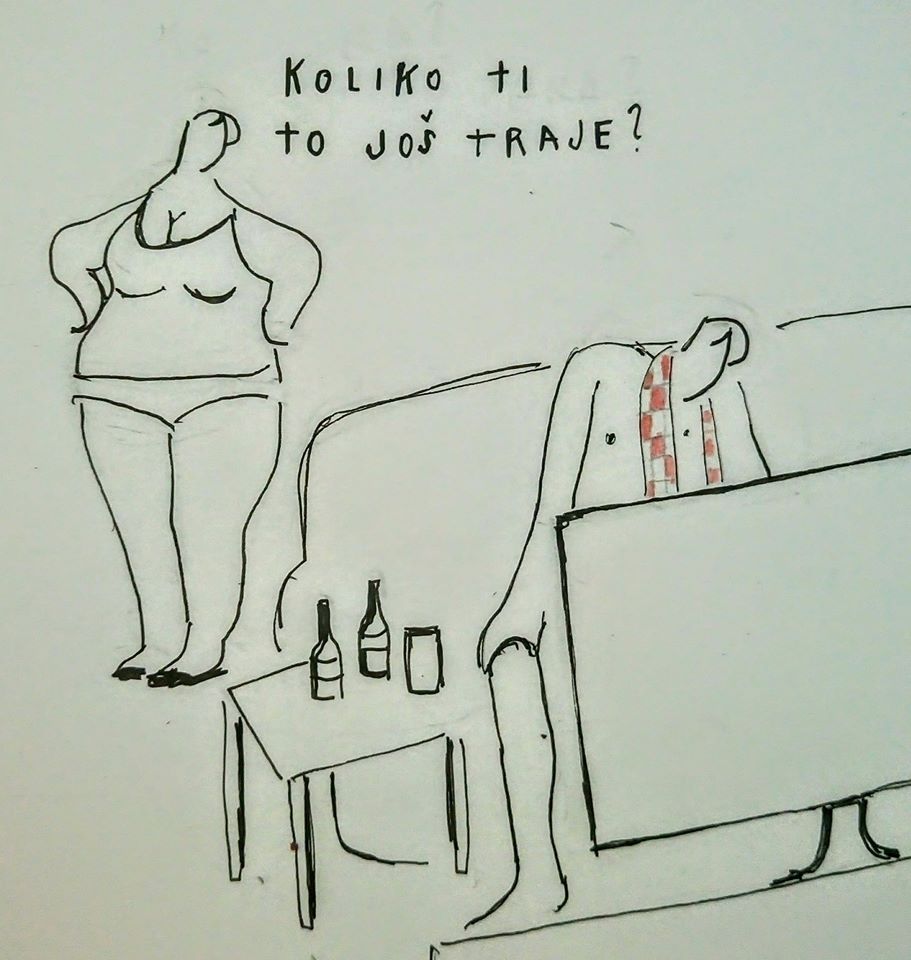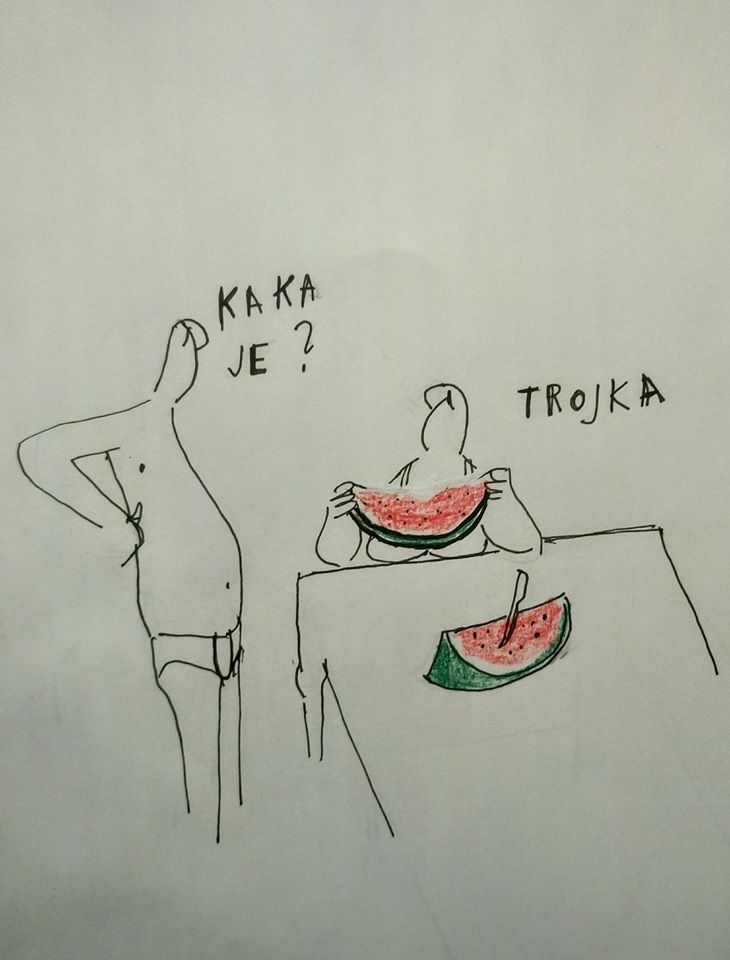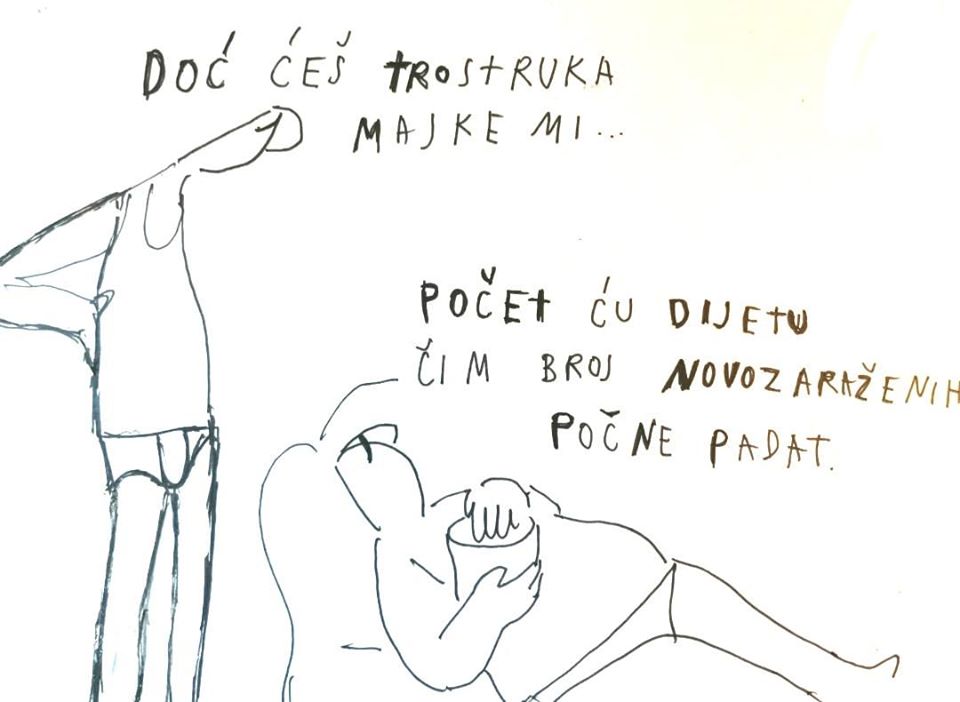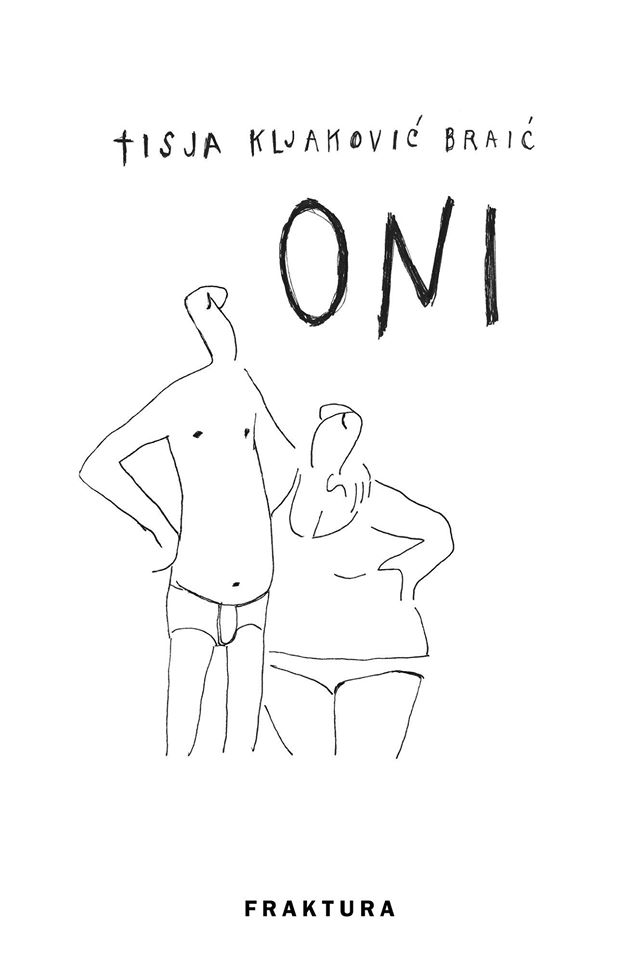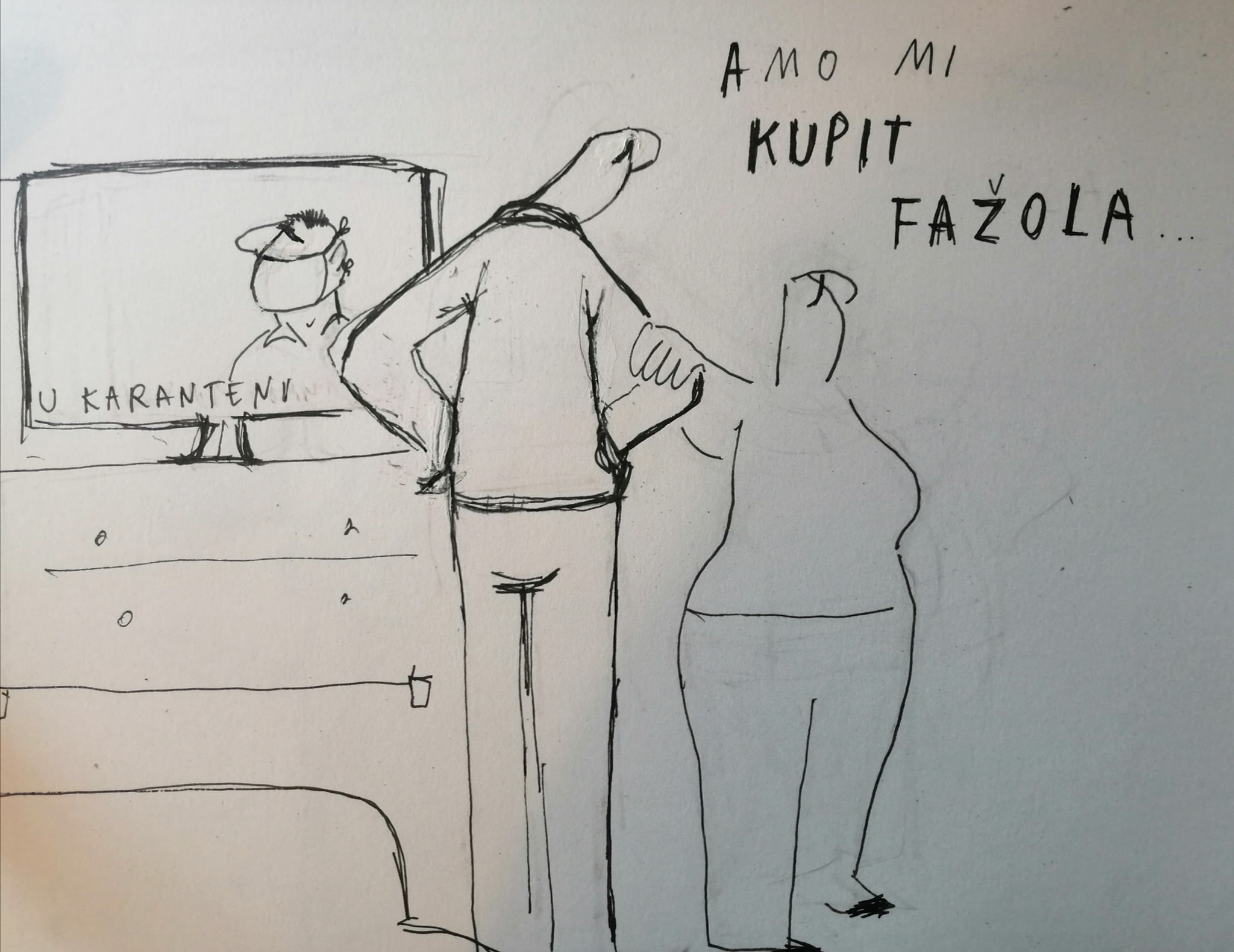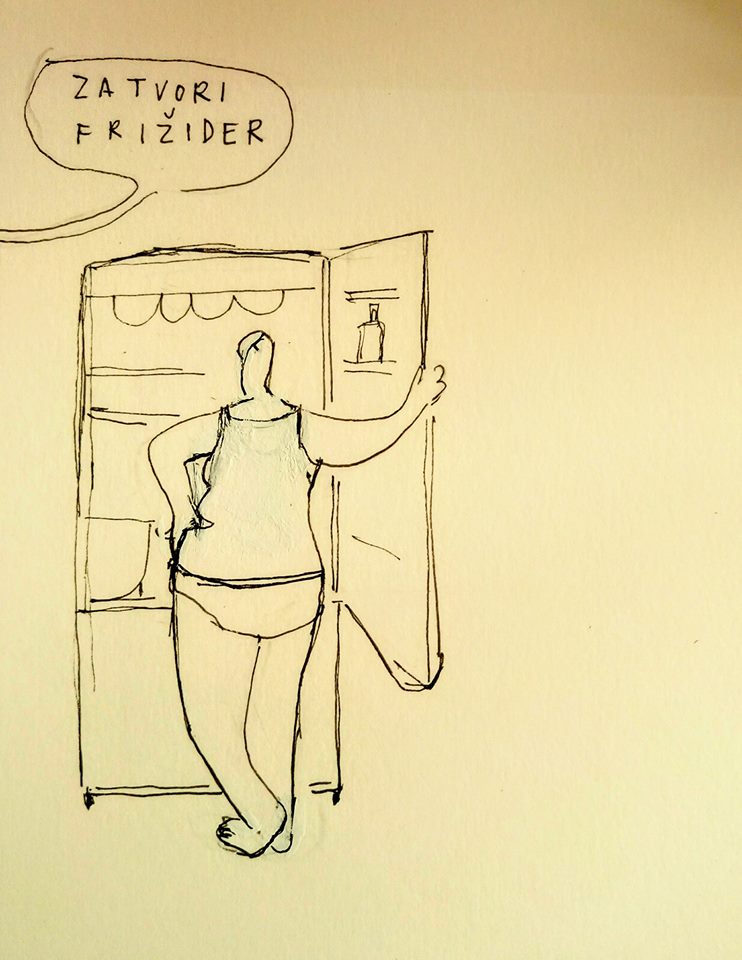NGO Urges Government to Take Measures to Safeguard Civil Society Work
ZAGREB, April 20, 2020 - Initiative For a Strong Civil Society on Monday called on the Croatian government to adopt measures to safeguard the work of civil society organisations in the wake of the coronavirus health crisis.
In its letter to the Government Office for Cooperation with NGOs, the Ministry of Labour and the Pension System, the Ministry of Regional Development and EU Funds and the National Foundation for Civil Society Development, the Initiative underscored that government representatives so far had not addressed the issues of civil society organisations' programmes and schedules.
They reiterated that it was the civil society organisations that had been most successful at drawing funding from EU funds and allocating it for contracted activities of public importance. They also underscored that numerous activities the organisations provided depended on those projects and programmes, as well as jobs of a great number of people.
According to data of the National Bureau of Statistics, about 18,000 persons work for civil society organisations.
The initiative underscored that is was vital that the government revised the decision to restrict the use of state budget funds earmarked for funding civil society organisations and that it should urgently publish the results of tenders by the European Social Fund and other funds that are in the process of evaluation, as well as proceed with planned calls for tenders.
More news about NGOs can be found in the Politics section.
Virtual Museum About Humanitarian D. Budisavljević in Preparation
ZAGREB, April 20, 2020 - The film "The Diary of Diana B." will premiere on TV on April 22, commemorating the escape of the last group of internees from the WW2 Jasenovac camp, and a project "From Film to Museum", dedicated to Diana Budisavljević, a great humanitarian who helped save children during the war, is underway.
The Hulahop production company said that the film would premiere on TV on the first channel of the Croatian Radio Television (HRT), on the occasion of the remembrance day for all victims and survivors of that Ustasha camp, and the same evening it will be broadcast on the first channel of Radio Television Serbia.
The future virtual museum will showcase unpublished material collected and created over many years of historical research and work on the film, and the completion of the project is planned for autumn.
"The Diary of Diana B." is a feature-length documentary "about the best people in the worst of times", among whom was certainly Diana Budisavljević, who together with a few friends organised an action that saved over 10,000 children from certain death by the end of World War II.
"The Diary of Diana B." premiered at last year's Pula Film Festival, where after eight minutes of applause from the audience it won as many as six awards, including the most important one - the Grand Golden Arena for Best Festival Film.
The film has so far won a total of 15 awards, and it played in cinemas all over Croatia, Serbia, Slovenia and Bosnia and Herzegovina, where it was viewed by over 65,000 people.
More Jasenovac news can be found in the Politics section.
New Balcony Demonstration Against Zagreb Mayor Called for April 24
ZAGREB, April 20, 2020 - The initiative Zagreb Is Calling You and the NGOs Green Action and the Right to the City are organising a new, third, balcony protest against the Zagreb mayor to take place on Friday, April 24 under the slogan "Bandić, give the money back".
The organisers are calling on citizens to bang their pots in order to show their dissatisfaction with the mayor's "wasteful use of city money on murky and unnecessary, often overpaid projects".
Each day, the chaos surrounding the repair of the damage caused by the earthquake becomes more evident, as well as the fact that these incompetent authorities were not able to systematically take even the most basic steps to repair the damage in a month's time, they said.
All this is happening in a city where the mayor manages about HRK 12 billion (€1.6bn) a year, while parts of the city still lack basic utilities, and many streets are littered with rubbish, the activists said in their call for protest.
The first demonstration against the mayor took place on April 3 and the second on April 17.
More Zagreb news can be found in the Lifestyle section.
Brilliant Caricatures of Dalmatian Life: Tisja Kljakovic Braic Interview
April 20, 2020 - How to capture the uniqueness and brilliance of the wonderful phenomenon that is life in Dalmatia? Meet Split artist Tisja Kljakovic Braic, author of the brilliant book of caricatures of Dalmatian life, ONI.
Dalmatia is unique. I love it to death and it frustrates the hell out of me. And it took me a full 15 years of living here to find the way to come to terms with my frustrations, which I can now summarise in a single sentence of advice for newcomers. Accept this sentence of advice from the beginning and live by it, and your life will be infinitely better. Refuse to accept it, and you will probably either quit Dalmatia in frustration or end up accepting it and living by it in several years. The sentence is a simple one:
Do not try and change Dalmatia, but expect Dalmatia to change you.
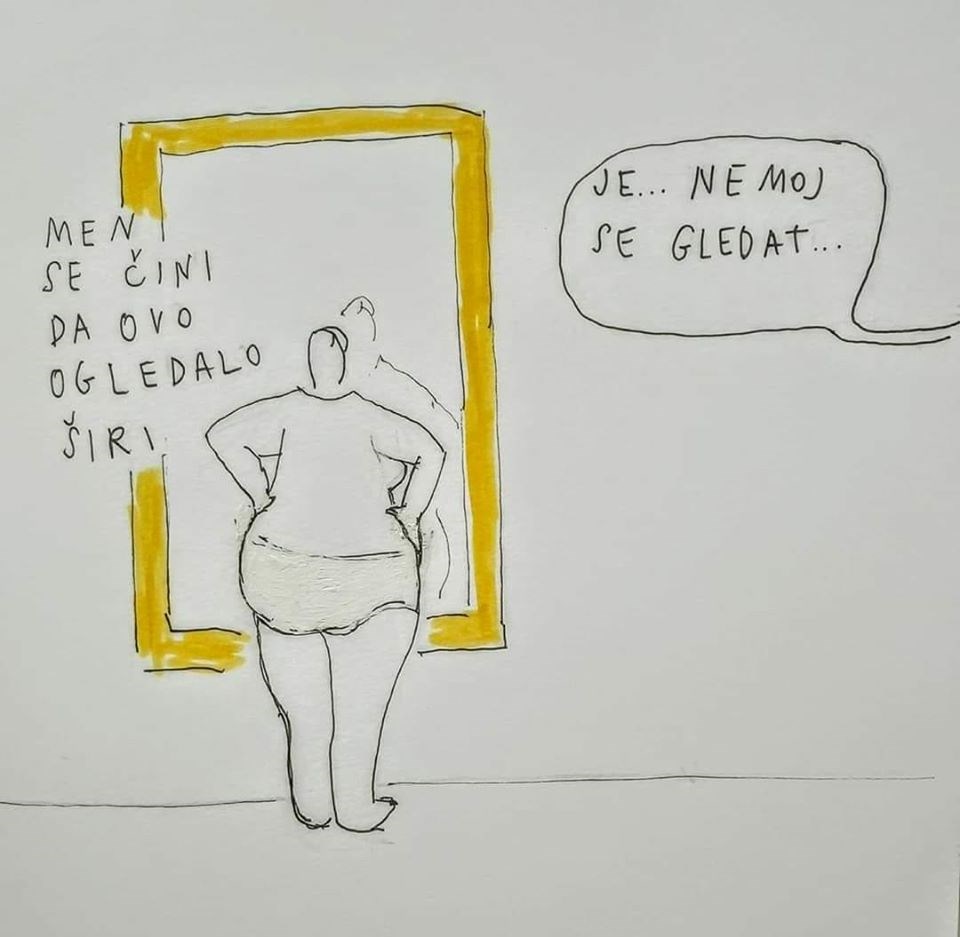
There are SO many things which are special and unique to Dalmatia and the habits of Dalmatian people. As a foreigner, when I highlight some of them, I am often accused of referred to outdated stereotypes. And so I was VERY happy to receive a truly wonderful Christmas present from my wife last year - ONI by Tisja Kljakovic Braic. I was laughing for much of the rest of the day.
Tisja kindly found the time for a quick interview about the book, Dalmatia and her plans.
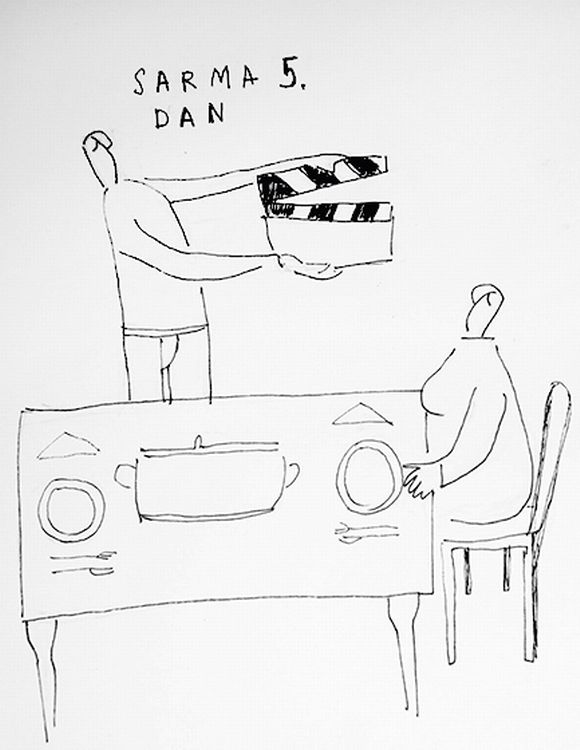
I will confess I have never laughed so much because of a Christmas present, EVER, after my wife gave me a copy of your book ONI. The sarma picture in particular. Tell us a little about the book, and why you decided to write/illustrate it?
They were created long ago in my paintings on wood. On them, Oni fly around in the blue sky and do everything they do in the songs. At one point, they came out in the form of drawings and started living real life. Many people call these drawings a caricature even though I never drew caricatures. On the contrary.
And so I posted my first drawing on Facebook, and I was glad that I could make people laugh. Soon, the drawings multiplied and I published a book called Oni that ended up becoming a great success.
What made them so popular is actually that they are so ordinary. Everyone recognised themselves in them. Oni doesn't have a filter.
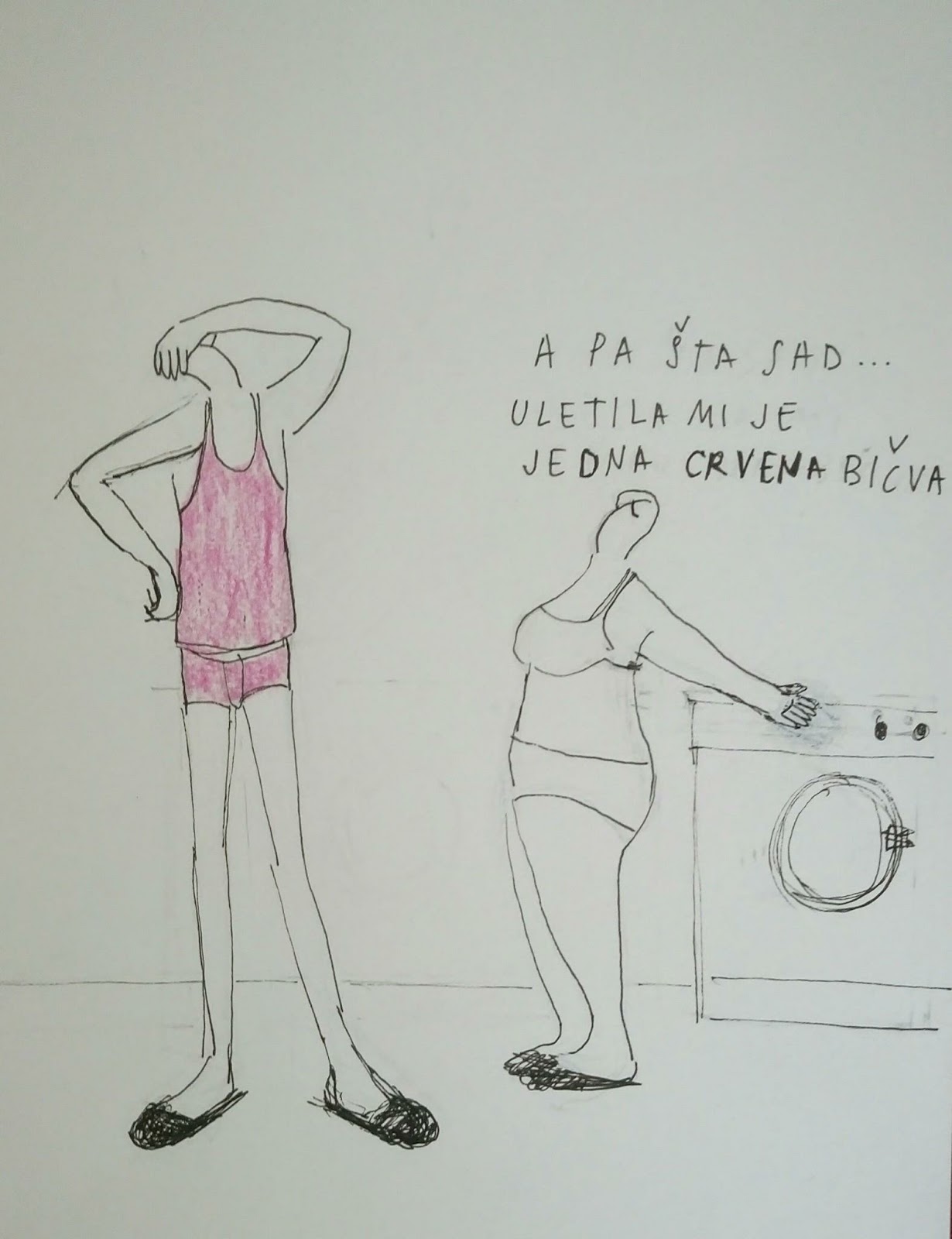
There are SO many observations of life in Dalmatia. When did you first start noting them and how long did it take to come up with the collection for the book?
I never thought about life in Dalmatia, given the fact that I live my life here. What is in my blood just naturally comes out. I thought that because this is all about typical Dalmatian things, the book would not be interesting beyond Dalmatia, but the opposite happened. Both Serbs and Slovenes bought the rights to the book.
Your illustrating style is unique and very distinctive. Tell us about it, and did you have any particular role models in your head as you did the illustrations.
It was always my dream for me to be able to draw everything in three moves and I finally succeeded. In the drawing, you can see the way they look at each other. I think by now, you can probably even hear them. The way they look, their height differences, however much I try to fight it... that's my husband and I.
However, they all bear characteristics of our parents, everything that once got on our nerves and everything that we'll eventually turn into ourselves.
The book ''Oni'' became kind of a marriage manual.
Can you give us five of your favourite illustrations from the book (please send the images) and tell us in a sentence each why they are special to you?
My favourite image is actually not funny. It has a poem in it, like my pictures do. I think a secret marriage hides within that picture.
How would you describe the following to a first-time visitor in Dalmatia in a paragraph?
a - a young Dalmatian male
b - a young Dalmatian female
c - a Dalmatian nona
d - a Dalmatian dida
I'll respond like this to this question - Fellini's Amarcord.
What is the thing that frustrates you the most about
Dalmatia?
Dalmatians?
That's like asking me what annoys me about myself, there's a lot and I won't say or admit anything.
What is the thing you love most about
Dalmatia?
Dalmatians?
What do I love about myself? It's not good to talk about those things, it isn't nice to brag. I'd just say that I wouldn't even change my neighbourhood, let alone my city.
What's next in the creative world of Tisja Kljakovic Braic?
Everything I've done, I've done without a plan and without a programme and it hasn't occurred to me to plan anything ever. There's also a book that I wrote about my childhood called ''The kid taken by the Devil'' which I wrote for myself as a memoir. In November at the Croatian National Theatre in Split, the premiere of a show based on that book should take place.
Everything I do is what makes me happy at that moment in time, and I don't think about anything longer than that moment.
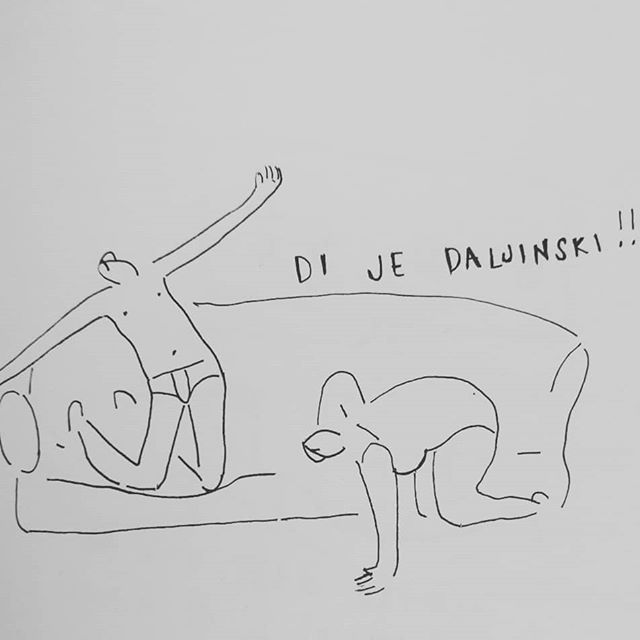
Thanks Tisja, and thank you for the many laughs. If you want to add a little humour to your day you can follow the official Tisja Kljakovic Braic Art Facebook page.
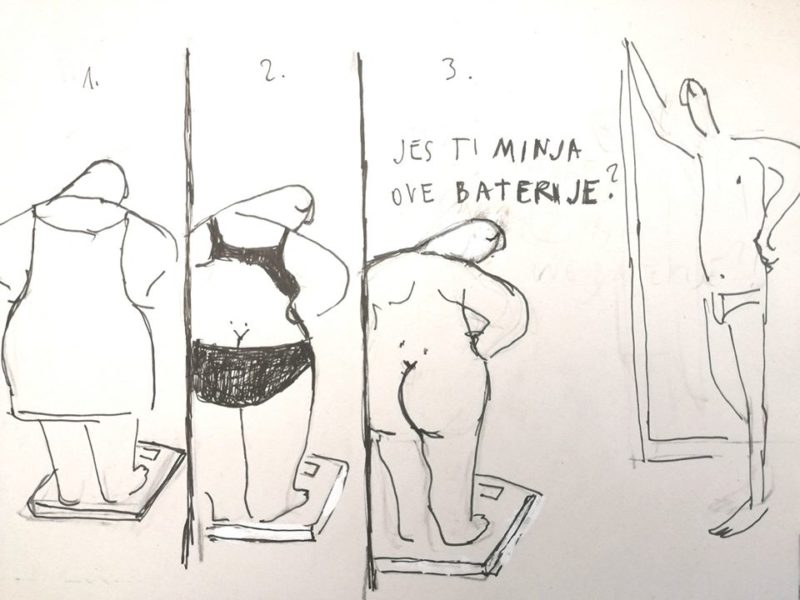
Coronavirus in Croatia: Testing Blood Samples Will Reveal Important Things
As Poslovni Dnevnik writes on the 20th of April, 2020, all citizens who have had their blood drawn since Wednesday for various health check ups unrelated to coronavirus (COVID-19) are potential candidates for conducting a major study to find out just how deeply coronavirus has entered the population, according to a report from Jutarnji list.
''The first phase will see the random selection of 1,100 blood samples, collected from hospital laboratories, health centres and public health institutes from across the country. Croatian labs have been keeping hold of blood samples since Wednesday. The collection will take about ten days, and by then we expect 1100 ELISA tests to arrive, which will determine how many people have developed antibodies, that is, how many, without knowing it, were in contact with the virus,'' Krunoslav Capak, the director of the Croatian Institute of Public Health, whose facility will be carrying out the testing, explained.
''At this stage, these will be ''anonymous'' samples, that is, only the gender of the person, their age and whether or not he or she is suffering from a disease or is completely healthy will be known. The person's first name doesn't matter to us. What we want to do is see how many people actually have had the virus asymptomatically. We chose such samples because we consider them to be the most relevant in terms of representing the population. Some countries have opted to use the blood of voluntary blood donors, but we believe that we wouldn't get a quality picture because most blood donors are healthy, middle-aged men,'' said Capak.
Considering the fact that this coronavirus is new and we're still in the research phase, this kind of study is being done for two reasons. The first reason is, as Capak explained, to see how many asymptomatic cases we have, that is, how many people have contracted the new coronavirus without even knowing it. The other reason is to see how many antibodies have, as such, been developed.
Specifically, it will be possible to monitor how long immunity to the disease lasts over time, which is something that is currently unknown and being questioned.
Make sure to follow our dedicated section for all you need to know about coronavirus in Croatia.
Croatian Institute of Public Health Publishes Guidelines for Catering Establishments
April 20, 2020 - A look at the guidelines for catering facilities in Croatia published by the Croatian Institute of Public Health on Sunday.
The Croatian Institute of Public Health (HZJZ) has published guidelines for catering establishments, according to which the catering objects of the following groups are allowed to operate: restaurants, bars (coffee shops, pubs, buffet, tavern and cellar) and catering facilities, but subject to all anti-pandemic measures and strict social distance measures.
HRTurizam presents the list as follows:
1. It is forbidden to serve meals, drinks or beverages within the property.
2. The buyer picks up their purchase at the door, window or just outside the door of the property.
3. Adherence to the highest hygiene standards and keeping a limited number of customers apart must be ensured in order to reduce physical contact and maintain a prescribed distance of 2 meters between buyers, sellers and buyers, and sellers.
4. It is recommended that, unless otherwise arranged, the installation of a plexiglass barrier/protection or other disinfectants meets all the requirements and safety measures to protect buyers and sellers.
5. Payment with contactless cards is recommended, if possible.
6. For cash payments, it is recommended that the buyer first puts the money on the counter and then takes the returned balance. After each buyer, the counter is disinfected.
7. The product (beverage, meal, etc.) should be ordered and paid for separately from where it is served/pickup, if this cannot be arranged, the seller must disinfect the hands between payment and ordering and disinfect the surface/counter between payment and ordering.
8. Ensure that no crowds are created and clear instructions are placed at all entrances and visible places.
9. If possible, it is recommended to ensure the flow of customers in such a way that there is a separate entrance/driveway from the exit/departure.
10. Prominently state instructions and recommendations for the observance of general hygiene rules and a strict measure of physical distance.
11. If a drive-in system is organized, it is forbidden to leave the car and the measures specified in points 3, 7 and 10 must be observed.
The director of the Croatian Institute of Public Health, Krunoslav Capak, explained how relaxed measures would look. As the measures are currently in place until May 4, the rules in cafes and restaurants will gradually be loosened. For starters, only those who have terraces and can provide distance to guests will be able to open.
He cited an example of cafes where people would not be able to sit side by side, and would instead sit one to two people at a table for four people. In addition, they will have to adhere to hygiene measures and disinfect everything after the guest leaves.
Stay tuned.
To read more about lifestyle in Croatia, follow TCN's dedicated page.
First Summer Habitat for Bats Created in Lonjsko Polje Nature Park
ZAGREB, April 20, 2020 - The first bat habitat has been created in the Lonjsko Polje Nature Park, and it meets all the criteria for being listed as an internationally important bat shelter according to EUROBATS's Agreement on the Conservation of Populations of European Bats.
Warmer weather brings about an increase in the number of insects bats feed on, so after their winter sleep bats start migrating to their summer habitats.
Bats will now for the first time come to their new habitat on the souvenir shop of the visitors' centre in Krapje. Since bats, besides forests and caves, also inhabit old houses made of natural materials, they had started to inhabit the walls of the souvenir shop four years ago.
Seeing as they impact the hygiene of the area, Lonjsko Polje Nature Park experts suggested that a bat habitat be installed. The solution builds on good practice in bat conservation worldwide. Two oak habitats with three chambers each were installed for bats on the wooden facade of the souvenir shop.
"Due to the coronavirus pandemic, bats have been unnecessarily stigmatised in the past few months. Bats in Croatia cannot transmit the virus to humans, and they are of great value for the ecosystem," Valerija Hima, expert manager at Lonjsko Polje Nature Park Public Institution, said on the occasion of International Bat Appreciation Day on April 17.
International Bat Appreciation Day is observed to inform the public about the importance of this protected species. Bats eat several hundreds of mosquitoes daily, contributing to the ecological balance by reducing the number of insects. Some rare bat species help to pollinate plants. There are about 1,400 bat species around the world and they live in nature, but also in urban areas, parks, gardens and buildings.
More nature news can be found in the Lifestyle section.
EU-Funded Projects in Croatia Going Forward
ZAGREB, April 20, 2020 - Croatian Regional Development and EU Funds Minister Marko Pavić said on Sunday that 400 million euros from EU funds had been redirected for medical equipment due to the COVID-19 epidemic, however, the EU funding of the ongoing projects was indisputable.
The funding of the existing agreements and conclusion of the planned agreements are certain, Pavić told the national broadcaster HTV on Sunday evening.
There is no question mark over any project underway, the minister said.
The beneficiaries of the projects have been given three more months for any deadlines so that there will be no need for extra paperwork or for any annexes to agreements in the current circumstances, according to the minister.
However, the situation caused by the coronavirus infection epidemic has led to the redistribution of some funds. Thus, €400 million has been reallocated for the purpose of procurement of medical equipment.
He explained that the shipments of medical and protective equipment coming from China to Croatia during the epidemic, which were not covered by donations would be covered by those redirected EU funds.
Pavić went on to say that the March rescue package also included an additional 140 million kuna for micro loans. In April, this set of measures includes 380 million kuna for that purpose to be ensured through the Croatian agency form SMEs, innovations and investments called HAMAG-BICRO agency.
Pavić expects about a billion kuna to be set aside for working capital from EU funds.
Considering employment measures, some €100 million from the European Social Fund will be made available to the Croatian Employment Service, he added.
More news about EU projects can be found in the Business section.
COVID-19 in Croatia: List of New Measures Explained
April 20, 2020 - In the last two days, the Civil Protection Headquarters in Croatia decided to extend some measures, while others have been loosened.
A look at the latest measures in Croatia, courtesy of Index.hr.
Extended measures:
- Measures to ban the assembly and operation of facilities such as cafes and non-food shops and a range of activities are being extended (extended until May 4)
- The decision on how to hold a funeral is extended. Funerals continue to be held exclusively within the immediate family and representatives of the religious community, subject to precautionary measures, no music, flowers or candles, and obituaries may not contain information on the time and place of the funeral (extended until May 4)
- The decision on measures for marriage and life partnership is extended. Weddings continue to take place within the immediate family and officials or representatives of the religious community, with respect to precautions, none of the participants should have a fever or symptoms of acute respiratory infection, and wedding ceremonies are prohibited (extended until May 4).
- Children's and sports fields continue to be closed (extended until May 4)
- Mooring ships in international navigation subject to quarantine or self-isolation measures are prohibited (extended until 18 May)
- The decision on border crossings for the transit traffic of freight vehicles is extended without organized convoys (extended until 18 May).
Loosened measures:
- Intra-county passes will be lifted IF requested by the counties and movement in these counties will occur smoothly, while passes will still be needed to move from one county to another.
- Zadar ferry from Ancona, which was suspended due to the coronavirus pandemic, will resume operations from April 26 twice a week for freight only (more here)
- Truck convoys entering Croatia have been terminated, drivers at the border will be informed that they are allowed to drive only on motorways and stop only at specific places.
Example of E-passes
The National Civil Protection Headquarters accepted the proposal of the Split-Dalmatia County Civil Protection Headquarters to eliminate e-passes, while previous measures are in force for the islands, with the exception that the e-pass is not required to move from one administrative unit to another on the island.
The head of the National Civil Protection Headquarters and the Minister of the Interior, Davor Bozinovic, on Sunday signed a decision to eliminate the necessary measure to ban movement from permanent residence and permanent residence in the area of Split-Dalmatia County.
Thus, as of April 19, the said measure for the entire county, except for the islands, has been lifted.
This means that persons residing or permanently residing in an island area can only leave the island with an issued e-pass. Also, for persons who do not have a residence or permanent residence in the Split-Dalmatia County island area, arrival on the island is possible only with an issued e-pass.
As of Monday, April 20, 2020, the e-pass is required only to go to the territory of another county or/and to the islands, that is, to an island in Split-Dalmatia County.
See the decision below:
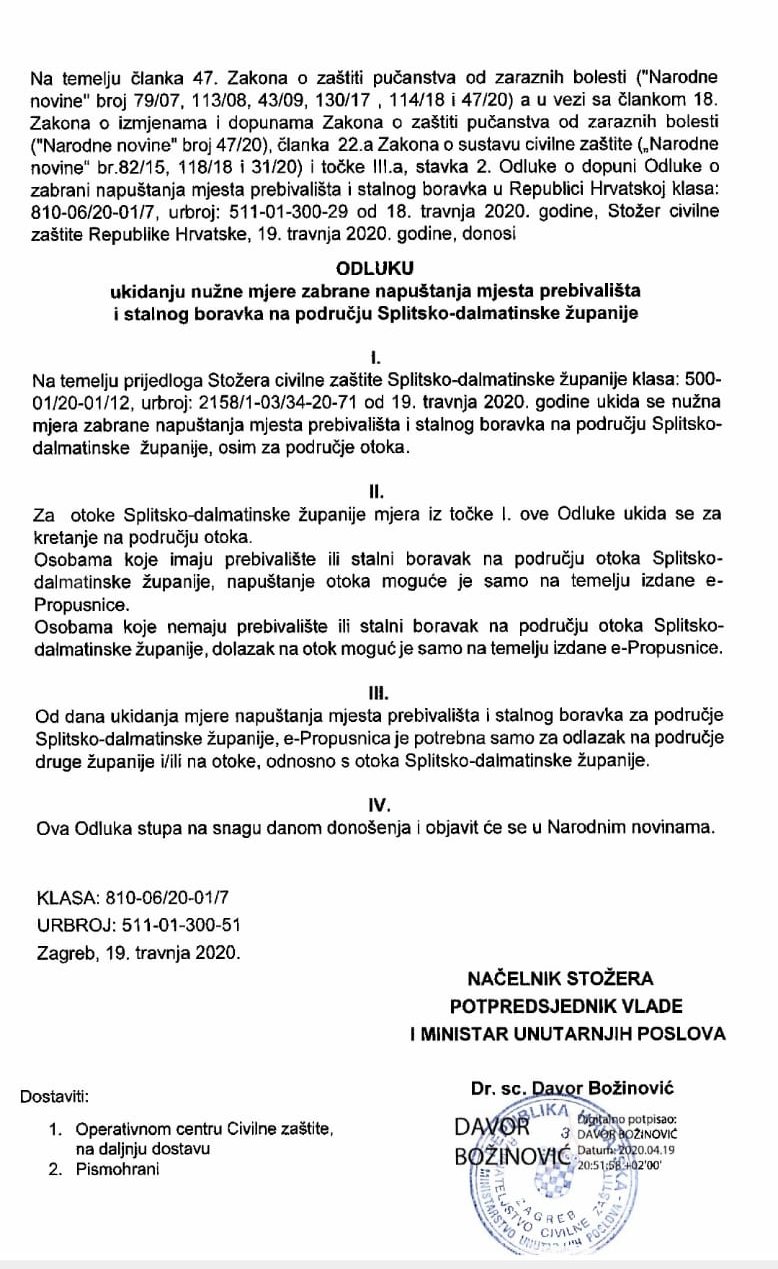
You find information on your county HERE
What could soon be lifted?
At the next government session, the ministers will propose what measures should be lifted for the economy to recover. This is followed by an epidemiological assessment for each of these requirements and then a discussion of what is estimated to be no epidemiological risk. A few days ago, Minister Beros said he hoped some measures could be loosened as early as next weekend.
Economy, Entrepreneurship and Crafts Minister Darko Horvat said a few days ago that he is sure that smaller crafts such as hairdressers can start working if shops can work. There were also references to tech shops, service shops, showrooms, but also bookstores.
It is also possible that some of these measures will be lifted in those counties where the epidemiological situation is better.
Capak announced the possibility of returning public transport but did not say how long.
"At some point, we will release public transportation, but not as it has been so far - with strict behavioral measures prescribed," Capak said.
There are also plans to open catering facilities and other services, and they will need to be organized with strict epidemiological measures.
"Hairdressers cannot use social distancing, but they can have protective equipment and disinfect everything they do. When the epidemiological situation permits, hairdressers will start working as well," Capak said.
Follow TCN's live updates on the corona crisis in Croatia
Igor Rudan: Why Singapore, Japan, Qatar and Emirates Now Have Coronavirus Outbreaks
April the 20th, 2020 - Can Croatia leave a long ''quarantine'' period? Here are the answers to seven very difficult questions, as explained by Professor Igor Rudan.
Six weeks ago, I published my first comprehensive article in the Croatian media on COVID-19. In the meantime, thanks to numerous articles by Croatian scientific journalists as well as scientists who have participated in the public debate, the public's understanding of the COVID-19 pandemic has increased. Thanks to this, In this text, I'll also offer answers to a number of new questions that have now arisen as time has passed.
1. What are the basic types of strategies that characterise the responses of most countries in the world to the spread of this new coronavirus infection?
Since taking anti-epidemic measures, we've seen four different types of strategies. I'll rank them from least to most interventionist. The first type of response was to allow the virus to spread among the population in order to expose as much of the population as possible to it, to ''get over'' COVID-19 and thus ''immunise'' ourselves against it while preserving normal life and economic activities to the fullest extent. Sweden, the United Kingdom, the United States, the Netherlands and, to a certain extent, Germany, led the way in this regard.
The second type of response was to rely on a deep "first line of defense", this was facilitated thanks to a high level of development, modern technologies, a strong capacity to test people for the presence of the virus, as well as the rapid monitoring and isolation of their contacts with modern technologies. The best examples of this approach were South Korea, Singapore, Taiwan, Japan, United Arab Emirates, Qatar and Iceland. The third group of countries, where the vast majority found themselves, after a short time, trying to stop the virus with the "first lines of defense" had to move to another plan which involved them closing the borders. They were then quarantined for several weeks to prevent the spread of the virus and significantly reduce the daily number of new cases of coronavirus infection. During the quarantine period, a plan for ''getting out'' of quarantine and co-existing with the virus until effective drugs or vaccines appeared was made.
Finally, the fourth example is countries that started with their quarantine measures early enough, or implemented them so intensively, that they practically eradicated the virus within their respective borders. China is an early example of this, but thanks to the success of its measures so far, there is hope for New Zealand, Vietnam and even for Montenegro.
2. What have been the results of individual strategies so far?
It turned out that all four initial approaches, after enough time, were more or less forced to switch to the same strategy, a quarantine of varying degrees of severity. Although they have sought to preserve their normal lifestyle and indeed their economy for as long as possible, the United States and the United Kingdom now have an enormous number of infected people within them. The United States is sure to have the highest absolute death toll after the first wave of the epidemic. The United Kingdom will also have a large number of coronavirus casualties. Germany is managing to keep the death toll quite low compared to the number of infected people, thanks to the spread of the infection among mainly younger age groups, as well as excellent epidemic prevention measures in hospitals and retirement homes, and the strongest intensive care facilities. The Netherlands, like the aforementioned countries, has since moved to stricter quarantine measures. Only Sweden continues to rely on the discipline of its citizens and its social distancing measures to try to keep the virus at bay. We'll see over time what the results of that move will be, and how much life is currently "normal" for them compared to the period before the pandemic. Currently, the death toll is significantly higher in Sweden than in a dozen countries with comparable numbers, but it's obviously not yet large enough to isolate the entire population, regardless of government recommendations.
Unfortunately, we're increasingly seeing that even those nations that have sought to defend themselves against the COVID-19 epidemic by maintaining a "first line of defense" are slowly yielding. For ten weeks, they have been fighting hard to prevent the virus from spreading freely among the population through mass testing and the rapid isolation of patients and their personal contacts. Although it seemed for a long time that these countries would succeed in this approach, Singapore recorded as many as 623 new cases on Friday and a real epidemic is now ''booming'' there.
The same is true for Japan with 556 new cases of infection, Qatar with 560 and the United Arab Emirates with 477 newly infected people in just one single day. All four of these countries have now introduced quarantines and substantially tightened their respective measures. Only South Korea and Taiwan seem to be succeeding in the "first line of defense" approach. There, the number of newly infected people is still successfully maintained at a low figure and without the need for quarantine, but with a massive amount of population testing and the use of highly intrusive methods of monitoring mobile telecommunications. These two countries have learned from the SARS experience and they were greeted by this pandemic excellently prepared, and they remain the only ones to still be resisting it with their "first line of defense."
Iceland and New Zealand have been able to reap the benefits of their favourable geographical locations and owing to that, they could, much like China, completely eradicate new infections on their territory. The best reaction in the world in general was probably that of Vietnam, another country which recalls the SARS pandemic very well. Vietnam recorded 63 cases and 5 deaths of SARS back at that time. Today, that country, with a population of almost 100 million, still doesn't have one single victim of COVID-19.
Admittedly, the same may be true of North Korea, but it's hard to know what's going on there at all. However, a new challenge for all countries that have managed to completely suppress the spread of the virus at an early stage is that in the next phase, every person entering the country will be a new potential source of the epidemic. Therefore, they will only be able to relax their measures when medicines or vaccines are developed, and until then, they will need to depend on the tight control of their borders and quarantine for everyone who enters them.
But what can be generally concluded is that, more or less, all countries across the world were forced, at least over time, to abandon their initial strategies and move to stricter quarantine measures, with the exception of only a few very rare exceptions, otherwise the extremely rapid spread of the new coronavirus simply couldn't be stopped.
3. Are the quarantine measures justified, given the real danger of the virus and the damage done to the economy?
In order to give a clear answer to this question, we should first know with sufficient certainty what the real threat of the virus is at the level of the entire population, and what are the economic, health, and any other indirect threats from ''halting the world'' in just several weeks. Unfortunately, at the moment, we don't know with sufficient precision the answer to any of those questions. Therefore, all countries are making their own decisions in the face of an entirely new and unknown situation in modern history. The extent to which their measures were justified will be carefully evaluated by science for years to come. The epidemiological profession is still trying to assess the real threat of the virus by employing various methods. The parameters of epidemiological models have been changing and refining for weeks with each new survey conducted. During this time, it's quite understandable that many people in Croatia, as well as across all other countries in the world, are now becoming very impatient. In Croatia, a specific problem could be that the results of our health care system's fight against COVID-19 are so good at the moment, that increasing numbers of people don't find the measures justified and start criticising them. They don't understand that the results are good precisely because the measures were timely and rigorous. In that sense, Croatia is slowly becoming a "victim" of its own good results.
However, most people in countries that have experienced a significantly worse and more severe epidemic than Croatia have quickly realised that the economy being "preserved" is very much an illusions until that country somehow manages to control the spread and effects of the new coronavirus. Just look at the world's largest power - the United States of America. There was huge public support there for no strict anti-epidemic measures to be taken if they would ultimately harm the whole nation rather than benefit it. The problem, however, is that in New York, Detroit and some other areas, many people are starting to die and hospitals are becoming heavily burdened overnight. The media's intense focus on monitoring the pandemic has forced most of the population to retreat into their homes, regardless of their plans and the recommendations in place for them. As a result, jobs began to vanish at an extraordinary rate, and the number of unemployed people in the United States has increased at a rate likely not seen since the "Great Depression" that began in late 1929, and it may now surpass it. Thus, in the USA, tens of thousands of people will die in the initial wave of this epidemic, and the economy will also receive a major blow.
However, there is still a lot of fairly loud and articulate thinking in the public opinion that, if that must be the price that needs to be paid to ''immunise'' the population and resume normal life as quickly as possible, along with the recovery of the economy, in the long run, such an approach will prove to be better than quarantine and the consequent collapse of the economy.
The premise for such thinking is that in this first epidemic wave, the level of the population exposure sufficient for "collective immunity" against coronavirus and stopping its further spread will be reached. This level, however, depends on the "spread rate" of the virus, ie - its infectivity. Unfortunately, the level of infectiousness of the new coronavirus appears to be higher than the initial estimates from Wuhan actually suggested. When infectiousness is higher, then the proportion of the population that needs to get over the infection to stop the epidemic and reach collective immunity is also higher.
With a very high level of infectivity, a sufficient proportion will no longer be 40 percent or 50 percent of those who have managed to acquire immunity, but perhaps more than 70 percent, or even 80 percent. In the US, however, not enough people have been exposed to the infection so far. Barely 10 percent of the total population has been infected there to date. However, in a country of almost 330 million people, this is a huge number, so the casualties are already very significant. Furthermore, in the context of population exposure strategies, while maintaining the economy, one should also have faith that this immunity will be long lasting. However, there has not yet been enough time for this to be scientifically investigated, let alone clearly confirmed. Finally, it's hoped that the genome of this virus will remain stable. If it mutates from year to year, much like the flu virus does, the immunity acquired the previous year will no longer protect someone the following year. If we don't receive the vaccine or effective medicines by then, we'll have to face a large number of new coronavirus victims once again, and all of the casualties of the first wave of the epidemic will be in some way futile, as that situation could have been prevented with the introduction of quarantine measures.
In conclusion, this major problem with COVID-19 may, in some unforeseen way, be resolved faster than it currently appears. After that, economies may then recover very quickly, or they may not. We're yet to see this in the coming months. Until now, in modern history, the development of the economy has always meant better human health. It also worked the other way around, too, meaning that the better health of the people also contributed to economic productivity. However, in this unusual and entirely new situation, the concern for public health threatens the functioning of the economy.
Moreover, there is no "theoretical model" of how much life can be reasonably saved, with the sacrifice of a percentage of the economy. Moreover, there are no good estimates as to whether this economic downturn will have worse health consequences than the pandemic itself. However, one of the most important reasons as to why the vast majority of the world's countries have chosen measures to physically remove people to prevent the spread of the virus is the fact that we still know too little about the virus itself. It seemed reasonable, therefore, for us to buy some time. This will give us a much better idea of what kind of danger we're dealing with and what strategies might or might not be effective.
Things are changing, quite literally, day by day, and it's becoming clearer which measures will work and which are less likely to succeed.
4. What does all this mean for the anti-epidemic measures being taken in Croatia and when they could be completely abolished?
Thinking about Croatia, maybe it might help to say that here, where I've lived and worked for two decades, in Scotland, about 50 people have died every day from COVID-19, with an estimated 1,000 casualties. It would be very similar in Croatia, if we were only two weeks late with these anti-epidemic measures. Unfortunately, this scenario can still happen to Croatia if we underestimate this virus after we leave quarantine, and coronavirus' free spread among the population occurs.
Even if 50 people died in COVID-19 every day in Croatia, it is likely that many people would retreat inside their homes. Then it would be difficult to save the economy and tourism again. If it were so easy to get out of this situation, countries across the world wouldn't be resorting to these strict anti-epidemic quarantine measures. In the vast majority of them, national economies are highly dependent on SMEs and as such, they're in the same situation. Therefore, you should work as actively as possible to plan your exit from quarantine as quickly as possible, but also to do so with a good deal of caution.
It's certainly good that we've shown in Croatia that we're able to curb the COVID-19 pandemic with anti-epidemic measures. Of the EU member states, Italy currently accounts for 22,745 deaths, Spain 20,002 and France 18,681, while the UK, an EU member until recently, had 14,576 casualties. Belgium, Germany, the Netherlands and Sweden have between 1,000 and 5,000 deaths, and even non-EU member Switzerland is in this class. Portugal, Austria, Ireland, Poland, Romania, Denmark, the Czech Republic, Greece and Hungary can count their death tolls in three-digit figures, as can Norway and Serbia, which are both outside of the EU.
Croatia, with 36 deaths so far after the first eight weeks of fighting the virus, is certainly among the most successful countries in the whole of the European Union. We have several hundred times fewer deaths than Italy, and I explained the reasons for this in one of my previous columns. These results still stand even in the face of reported incidents of the spread of contagion in retirement homes and in healthcare facilities. Only Slovakia, Latvia and Malta currently have fewer deaths than Croatia within the European Union. This is certainly encouraging is a praiseworthy success for Croatia's National Civil Protection Headquarters and epidemiologists.
However, I've already stated in my earlier columns that if one wants to understand the true state of affairs with this epidemic, one should always look first at Singapore, the United Arab Emirates, Qatar and Japan. These are ambitious nations that strive to be the best in the world in solving every single task. That's why the state in those countries is the most reliable reflection of what can be expected in the best case scenario. All four of these countries currently have freely spreading COVID-19 outbreaks, and they've introduced strict quarantines - something that only a handful of people would have expected a week or two ago.
What does this mean for Croatia? Suppose we managed to reduce the number of people infected within the Croatian borders to just a hundred by quarantine. Those 100 or so infected people aren't visible to us yet. Specifically, we have yet to discover them through testing. We will be able to do this based on the symptoms that they will all develop following the loosening up of the measures. Some may have already started developing symptoms, but they have not yet reached the stage of the disease in which they need to be tested.
Unfortunately, if all the precautions are completely absolished, those one hundred infected people will lead to a thousand infected in just one week, and a thousand in the next week, then to ten thousand. This will mean a new quarantine, but it will probably go on for longer this time. Why is that? Because of those 10,000 infected people that we expect to develop symptoms of the disease, about 5 percent of them will need intensive care and respirators. That's as many as 500 people. Therefore, the number of casualties in Croatia during that second quarantine would add at least 200 or 300 more to the death toll in the first wave. This would be a likely consequence of just two weeks of the complete loosening of all of the anti-epidemic measures. This virus is spreading so quickly, and so easily, with an enormous speed of spread, and that in itself presents us with big problems and some very difficult decisions to make.
I'd like as many people as possible to understand that an uncontrolled COVID-19 epidemic has occurred in Singapore, the United Arab Emirates, Qatar and Japan over the past two weeks. For the first time, the virus forced them into taking harsh measures of social isolation. If we don't want the same thing to happen to us in Croatia two to three weeks after the loosening of the measures, and then being forced to quarantine another two months during the tourist season, we'll need to be more thoughtful and successful in our "loosening" of the measures than they were over in Singapore, the United Arab Emirates, Qatar and Japan. Just think for a second about that sentence. Can we do that? We'll definitely try, but I really don't know. If they failed, we will now need another highly anticipated endeavor to avoid such a scenario and another wave of epidemic for Croatia.
5. If it's too difficult to assess the effects on the economy and other indirect adverse effects at present, when would we at least be able to determine the real danger of the virus? Recent reports from several countries have reported dozens of times more infected people than those found by testing. Doesn't that mean that COVID-19 is nowhere near as dangerous as it seemed?
It may be time to return to the very beginnings of this epidemic, as well as the "infodemia" in Croatia, and try to clarify a few important facts. The danger of a virus in any epidemic depends, in principle, on its two basic characteristics. In my popular science articles, I refer to them as the "rate of death" and the "rate of spread". I do this for clarity because there are other professional names for them.
In my first address to the Croatian media back at the end of February, I explained that the "death rate" was calculated by dividing the total number of deaths from COVID-19 by the number of all who were infected with the virus. The English name for this parameter is "case-fatality rate". I explained that for the COVID-19 infection, the death rate cannot be 3.4 percent, which is an estimate made officially by the Director of the World Health Organisation. Specifically, with the 3.4 percent estimate, the denominator was based only on persons who had reasons to be tested and ended up being positive for coronavirus. In doing so, the denominator didn't include all those infected who weren't tested, and we cannot know how many of them there were.
We knew then about the Hubei province that about 3,000 died and that the number of deaths divided by the number of confirmed infected was 2.9 percent, and in the City of Wuhan, it was as high as 5.0 percent. Based on the experience of previous respiratory outbreaks, I didn't believe that it meant that every twentieth infected person would die. Specifically, infected physicians at Wuhan's hospitals had a significantly milder clinical picture when infected with coronavirus when compared to their patients with severe COVID-19. This was a sure sign that patients in hospitals represented only the extreme, that is, the most severe part of the much broader range of symptoms among the wider population. How many more were actually infected on the streets of Wuhan and had milder symptoms? No one could know that.
Wuhan is absolutely huge and there could be as many as 100,000 infected people at the time, as the first figures on the "death rate" roughly indicated. But there could be as many as a million, so those first rates should then be divided by ten. But because of the size of the Wuhan, the figure could theoretically be as high as ten million, so, those first rates should be divided by one hundred. So, I then assumed that the number of infected people should be at least several times the number of people who tested positive for coronavirus in Wuhan, and instead of death rates of 3.4 percent for the world, 2.9 percent for the Hubei province, or 5.0 percent for the City of Wuhan, I recommended that a large number of people who have milder symptoms and hadn't been tested needed to be taken into consideration too.
Then, on Sunday at 2 (Croatian TV show), I put in an estimate that was between 0.5 percent and 1.0 percent. However, in doing so, I said that even a "death rate" of 0.5 percent was actually a "conservative" estimate, since those infected in Wuhan could in principle be between ten and a hundred times higher, due to Wuhan's sheer size. Therefore, the rate of death in the community of COVID-19 could be as low as 0.5 percent. But, if it is indeed less than 0.5 percent, it's already in the rough area of the rate of death from more severe flu, for which we don't have a vaccine.
However, until we have a good understanding of what the denominator is, we won't be able to properly assess the risk of this new coronavirus. Over recent says, we've finally been getting the first reports from the Netherlands, Denmark, Italy, Iceland, but to me, the most valuable of them all are from my long-time acquaintance and highly regarded colleague, Professor John Ioannidis from Stanford University in California. His research seems to me to be the best designed and implemented. Researchers at all of these sites have finally begun to search for antibodies in the blood that indicate that people have become infected with COVID-19 and have become immune to the virus without even knowing it.
When such a survey is conducted on a sample of the entire population - for example, among voluntary blood donors or a randomly selected sample of volunteers - we say that we're carrying out so-called "seroprevalence".
Efforts are made to determine the frequency of previous population exposure to the virus with the demonstration of an immune response. What are the conclusions of the first studies conducted in as many as five different places? They're exactly what epidemiologists have assumed from the beginning. The number of people infected with the new coronavirus was several dozen times higher than the number tested positive in all of the aforementioned countries. A percentage of the population is now infected, but it's still less than 10 percent. In the California survey, between 2.5 percent and 4.0 percent of the population were infected.
What does that mean? In those countries where "death rate" in the figure have been contributed to by numerous deaths in retirement homes, this will mean a death rate that will be within my projected range, ie between 0.5 percent and 1.0 percent. But in Santa Clara, California, where this wasn't the case, it would mean a "death rate" of between only 0.12 percent and 0.2 percent, therefore - quite comparable to a a more severe flu, even with vaccination. This is in line with my previous interpretation of the events in Wuhan and Italy, which no longer seemed possible to many because of the way the crisis was being reported on there.
These new insights also explain that everything that experts, scientists and the national civil protection staff have said from the start about COVID-19 hasn't been wrong. There are two reasons, however, why the correct interpretation of the danger of COVID-19 to the public may still seem wrong for a long time. The first is that the public in general, as I've learned in recent weeks, doesn't even have an approximate impression of the danger of influenza as an infectious disease. Flu is not a "virus", neither is it "just a flu", nor is it "a little case of the flu". The real flu is a disease that claims between 250,000 and 650,000 victims worldwide every year, even with vaccination readily available. Now in Croatia, the public has finally started to realise that in flu season, respirators in hospitals for infectious diseases and other hospitals across the country are completely occupied. In Italy, about 20,000 casualties were attributed to the flu during the 2014-15 flu season, and as many as 25,000 in the 2016-17 season. Over in the US, as many as 61,000 deaths were attributed to the flu in the 2017-18 season. But the impression of the population about the danger of the flu has become so mild that people don't even borther to get vaccinated, although they're free to do so.
I explained even then, at the very beginning, that the panic about COVID-19 in Croatia wasn't reasonable, because in the Croatian population, this new virus will have effects similar to the more severe influenza for which we don't have a vaccine, but we will be able to stop it with a series of anti-epidemic measures, such as by those which have been employed. This has been claimed by other Croatian scientists as well as by members of the Civil Protection staff.
Flu is, of course, a completely new and different disease each and every year. During the course of about three and a half months a year, during its season, influenza in Croatia can take up to 100 victims directly, and up to 500, or even more, indirectly, by exacerbating their existing diseases. The Seattle-based American Institute for Health Metrics and Evaluation, in its latest estimates, predicts that between 50 and 200 may die from COVID-19 in Croatia by autumn 2020. So, this prediction is also in line with the initial predictions I made. The peak of the epidemic wave in terms of deaths is scheduled for Croatia on April the 20th, 2020, meaning right now, and that's exactly what we're witnessing.
I hope that Croatia's results so far, as well as all of this data, will contribute to the public's continued confidence in the epidemiology profession. Another reason why the comparison with a more severe flu appeared to have been wrong was the events in Italy and the way they were monitored by the media. Namely, everything we watched and listened to from Italy for weeks was incompatible with our estimates that this was not a very dangerous and pernicious epidemic. However, in my previous articles, I tried to explain that in Italy we were looking at a COVID-19 picture in which the epidemiological response was missing, ie, things werre significantly delayed.
As a result, the number of infected, and thus of the dead, rose very sharply to several hundred times the numbers that epidemiologists would have initially expected. Then, the situation was dominated by epidemics in retirement homes and hospital wards. There, the "death rate" from values of less than 1 percent rose to about 10 percent. This is because the virus spread rapidly among the population who were most likely to die. The average lifespan in Italy was about 80. Almost 90 percent of the deaths were in people who were over 70 years old, and in the vast majority of those cases, every one of those individuals was already suffering from one or more serious illnesses. All this important information was not clearly communicated by the media. They reported only on the huge number of deaths, and occasionally any isolated younger patient, and terrifying individual testimonies.
However, in my first public address at the end of February, I announced that the victims would be predominantly elderly people, and for most COVID-19 victims, their lives would be shortened by a few years, which would be spent at an older age and undergoing treatment for pre-existing illnesses.
I'd also like to recall another important detail now that I also emphasised in all of my first media appearances, but due to the then lower level of understanding of pandemics then compared to today, few people noticed and understood it. At the time, journalists paid the most attention to the question of whether the virus could mutate to increase that "death rate," and thus start killing more people among everyone it infects. Of course, this is what they cared about the most, because that, at first glance, seems to be the most important information. But I kept saying at the time that the virus could mutate in another way, that is, it would start spreading more rapidly among people, and I said that, personally, I was much more afraid of the developments if things went in that direction.
But, the idea of the virus spreading too quickly seemed far less important to people at the time than the death rate. The rapid spread of the virus puts epidemiologists in greater trouble when planning anti-epidemic measures than the "death rate" itself does. Even a high "death rate" at which we can still easily monitor and isolate all infected persons and their contacts is easier to deal with epidemiologically than a low "death rate" with very rapid spread. The best example is this new coronavirus, which has caused us significantly greater problems with its death rate of less than 1 percent compared to SARS, MERS and Ebola, whose death rates were 10 percent, 35 percent and about 50 percent.
When the virus arrived in Europe, my greatest fear, unfortunately, came to fruition. The virus' "spread rate", which was significantly underestimated initially, made it significantly more dangerous than its "death rate." Initial estimates of the "spread rate coefficient" were around 2.2, but now there are estimates suggesting a figure of 5.7. This would mean that each infected individual could infect another five to six healthy individuals. It is possible, however, that this estimate is a little bit too high - my own calculations currently suggest an R0 number of between 2.5 and 4.0 when the virus spreads freely in most countries. But, that is also extremely quick and should not be underestimated.
6. If the "death rate" is now almost certainly less than one percent, and it may turn out to be close to 0.2 percent, which would correspond to more severe flu, does this mean that we can end the quarantine measures and ignore COVID-19, just as we neglect the flu?
I would be the happiest person to be able to say that this is the end of a major public health emergency. However, many things in this pandemic are much more complicated than what is typical for public communication on most other topics. Therefore, I will try to explain why the conclusion that follows from the reduced estimates of the "death rate" is still not all that simple. Namely, unlike more or less all other diseases that the Croatian healthcare system is facing, this virus also has a "fourth dimension" - time - that causes us problems that we're not used to in medicine. In medicine, there are too many cases of capacity-related illness mainly when the trauma clinic needs to deal with injured people from a large train or bus collision. Another example is wartime surgery, where several surgeons have to deal with the sudden emergence of a large number of wounded people in an unforeseen battlefield tragedy. But beyond that, too many patients aren't something we often have any real reason to think about.
So, let's suppose for a moment that this relatively small "death rate" when the new coronavirus is spreading among the population, which we can now slowly assume will be somewhere between 0.1 percent and 1 percent, is really the only danger associated with it. Then the new coronavirus could be compared to a monster slowly approaching us from afar, but we can see more and more clearly that the monster is physically small, that is, it reaches our navels when up close. So, we begin to relax, because whatever it is, we'll be able to knock something so small to the floor and master it. But, we're only looking at it from the front, we're not taking care to check what it has behind its back. There, in a dimension we cannot see, he is hiding three metal bars. When he finally stands before us, if we let him out of our sight for one moment and relax, he will be able to hit us over the head with one of these metal bars at an unbelievable speed.
The first problem that the new coronavirus causes us from that fourth dimension, beyond the death rate itself, is its absolutely incredibly rapid spread. If we allow it to spread freely among the population, it will infect up to one million Croats in just over a month from just one infected person. Even with a small "death rate", in just a few weeks, we will have thousands of severely ill patients, with fewer than a thousand intensive care units with respirators available.
All those who don't receive care will then simply have to die of suffocation.
They would die in hospitals alone because their family should not be in the infected ward. The burial conditions of all the deceased would also be extremely limited and quite different from the usual customs. I believe this is not a fate that anyone would wish on an older member of their family, and it should be avoided. This brings us to one big problem. Another big problem is that the new coronavirus has two faces. When spread in the community, it goes around relatively harmlessly, causing mild to moderate symptoms in most people and boasting a fairly small "death rate". But, when it enters into a vulnerable population, such as hospital wards, rehabilitation centres, or retirement homes, it spreads at a tremendous rate, because everyone is particularly receptive. We have also seen this in Croatian retirement homes. It also increases its "spread rate", but this is an even smaller problem in these situations. The bigger problem is that the coronavirus "death rate" then increases by at least ten or twenty times, and among such subgroups, it can kill up to every fifth or tenth infected person, depending on how old and sick they already are.
In many European Union countries, a very large proportion of the total number of deaths is caused by severe outbreaks occurring in retirement homes. This is another major danger that I have pointed to from the beginning, writing that anyone who brings the infection with them into a retirement home can contribute to the untimely death of twenty or more people.
The third metal bar this little monster has in its arsenal, that is, the third big problem that we have no answer to, is the indirect effect of the virus on the health system, which causes mortality from all other diseases to increase rapidly. Specifically, if the virus was simply allowed to spread freely, hospitals would temporarily be crowded with infected patients, doctors, nurses, as well as people who come for checkups or visits. The vast majority of health care professionals would end up either on sick leave due to COVID-19, or in self-isolation so as not to spread the infection to patients in serious conditions. To prevent hospital outbreaks with a significantly higher "death rate", as many patients as possible should be evicted immediately to be cared for at home. There would be a complete disruption of the functioning of the health system at all levels, which would cause those with other health conditions to die more frequently and more quickly.
These are the three big problems that no one in the world has a clear answer to yet and why more or less everyone has resorted to going into quarantine. In Croatia, these measures have now been in force for about one month. Thanks to them, the Croatian death toll is among the smallest in Europe, with thousands of deaths occurring across many other European Union countries. The three problems I just mentioned have also been prevented to a substantial degree. I hope that all the subsequent analyses will show that quarantine for four weeks to avoid all these problems was worth it. But now, it's necessary to ''get out'' slowly, but with enormous caution. The virus is still among us and we have seen at what speed it will continue to spread if we allow it to do so. The first quarantine decision also allowed us to think about supporting the economy. But a second quarantine would really hit the economy hard and frustrate the tourist season. Therefore, one should think about all of this the loosening up of these measures is introduced.
7. What are some new pieces of news from the world of science that we should pay attention to?
It should be noted first that all scientific research on COVID-19 is currently being conducted in a way that would otherwise be unacceptable to serious science in other circumstances. Work is done at speed, on small amounts and and often not sufficiently representative samples, it highlights the numerous imperfections of research design, many details that otherwise must be taken into account are being ignored. All of this leads to a real epidemic of superficial research, seeking to answer the open-ended questions as soon as possible. Unfortunately, a quick and wrong answer can do more harm than one that comes a little bit more slowly but ends up being correct.
An additional issue is that just about every piece of published research is receiving a lot of media attention from all over the world, and more and more often that results in so-called "pre-prints", that is, scientific papers that anyone could write and publish on a platform for pre-publications, without them having had any serious scientific and professional review. It will be clear to scientists whether it is serious research or it has major shortcomings, but journalists will have a harder time assessing that. Therefore, we should expect a full set of reports on various "scientific research results" from day to day, which will prove to be false or unfounded in about a week or two. It's a shame that so much time and media space is constantly being spent on completely unfounded reports and results. But it is one of the basic features of this "infodemia" that has now taken hold.
I'll only provide you with a brief overview of the most important open-ended questions and scientific insights that have been written in recent weeks here, which will be worth following in the coming weeks. Several science news outlets currently appear to be unfavourable in the fight against COVID-19, but much more needs to be investigated. It seems that the virus can come back to the bodies of those who have already had it and got a negative coronavirus result on the test. This is now being investigated in more detail, as it is possible that the tests aren't reliable enough, or that it may take much longer for the virus completely disappear from the body than was initially thought. However, if it turns out that those who have already had the disease can become infected again very soon after getting over it, that would be pretty bad news indeed.
It would mean that the immunity acquired after having the new coronavirus is not permanent, and that the vaccine may not be able to help as much as we had hoped it would. But, it's still far too early for such conclusions, new and better research needs to done. Furthermore, it is less and less likely that the virus will disappear with the arrival of warmer weather, as recent data from West Africa and many other very hot and humid places shows that it is still spreading rapidly and very successfully there. When the numbers of infected and dead people in a large number of countries are reduced, few countries will be willing to open their borders freely without two weeks of isolation on the cards for all who enter.
This will make international travel significantly more difficult in the coming months, so we should expect domestic guests in the tourism industry, and that's if we manage to avoid entering into another quarantine. Foreign guests pose quite an uncertain question at the moment, but let's still allow for the possibility that some positive turnarounds may occur in the coming weeks, which would change the current pessimistic forecasts. The bad news is that the antiviral drug lopinavir, which works by inhibiting proteases, and together with ritonavir, which is effective against the HIV virus that causes AIDS, has not shown efficacy against COVID-19. This was expected to be the case.
Still, there is some positive news to be had. For the time being, by comparison with the data from China, Italy, Spain and the US, the new coronavirus hasn't mutated in terms of a higher "rate of death" or a higher "rate of spread", but it turns out that its genome is more stable than that of the flu virus. In addition, there are some of the first indications (that science has yet to confirm) that blood plasma transfusions from those who have recovered from COVID-19, through early-response circulating antibodies, can be effective and give a bit of hope to severely ill coronavirus patients.
However, more research will be needed before we can think about such a recommendation, even though it does make scientific sense. The best two news stories, however, are the early described efficacy of the antiviral drug Remdesivir, which I know from my colleagues is already available to patients in Croatia. This drug, which is extremely elegant in its way of fighting RNA viruses, was supposed to be a cure for Ebola, but it didn't show the desired efficacy. However, this drug is an adenosine analogue and is inserted into the strands of the viral RNA molecule, ie the genetic instructions of the virus, causing the premature termination of protein synthesis which is required for new viruses.
In the first study, it showed possible efficacy in about two-thirds of severe coronavirus patients, and the mortality of those on respirators decreased from about 50 percent to 15 percent. Because of this, Remdesivir is currently a new news item that needs to be closely monitored. However, it should also be noted that the studies conducted so far have not adhered to the usual standards, they have been conducted without a control group, and we will require much more extensive and better-designed research to properly understand the effectiveness of Remdesivir. But in light of all current insights, Remdesivir, with the knowledge of a lower "death rate" in the community, is still the best news we currently have on the matter.
This text was written by Professor Igor Rudan, was first published on Vecernji list, and has been translated into English by Lauren Simmonds
For more on coronavirus in Croatia, follow our dedicated section. For more from Professor Igor Rudan, follow his author page here, his LinkedIn here, his Facebook page here, his Twitter here, and his Medium profile here.

